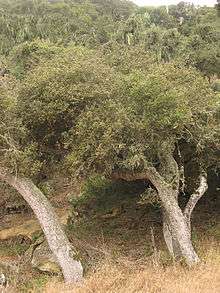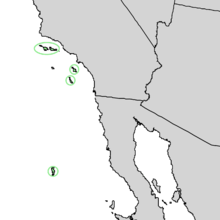Quercus tomentella
| Quercus tomentella | |
|---|---|
 | |
| island oak, Santa Rosa Island | |
| Scientific classification | |
| Kingdom: | Plantae |
| (unranked): | Angiosperms |
| (unranked): | Eudicots |
| (unranked): | Rosids |
| Order: | Fagales |
| Family: | Fagaceae |
| Genus: | Quercus |
| Section: | Protobalanus |
| Species: | Q. tomentella |
| Binomial name | |
| Quercus tomentella Engelm. 1877 not Jord. 1903 | |
 | |
| Natural range of Quercus tomentella | |
| Synonyms[1] | |
|
List
| |
Quercus tomentella, the island oak,[2] island live oak,[3] or Channel Island oak,[4] is an oak in the section Protobalanus. It is native to six islands off the coast of California and to one Mexican island: five of the Channel Islands of California plus Guadalupe Island (part of the State of Baja California).[5]
Description
Island oak is a tree growing up to 20 metres (66 ft) in height.[4] The mature tree has a grayish to reddish brown trunk with scaly, furrowed bark.[2] The twigs are reddish and covered in woolly hairs. The leathery leaf blades are often concave and are an oblong lance shape or oval with pointed or rounded tips. The edges are smooth or toothed.[4] The upper surfaces are dark green and lightly hairy when new, losing the hairs over time. The undersides are gray-green and coated in woolly hairs, becoming less woolly with age.[2] They are usually 7 to 10 centimeters (2.8-4.0 inches) long, sometimes up to 12 cm (4.8 inches). The acorn grows singly or in pairs. The cup has thick scales and woolly hairs and is up to 3 centimeters (1.2 inches) wide. The nut is up to 3.5 centimeters (1.4 inches) with a rounded tip.[2][4]
Biology
Island oak hybridizes with canyon live oak (Quercus chrysolepis).[4]
This species is a relict. Though it is now limited to the islands, it was once widespread in mainland California, as evidenced by the many late Tertiary fossils of the species found there.[4]
Conservation
The island oak was listed as a vulnerable species by the International Union for Conservation of Nature in 1998.[6] Its NatureServe conservation status is also vulnerable.[7]
The species is threatened by overgrazing. The most rapid declines have occurred on Guadalupe Island.[6] The trees there are apparently no longer reproducing.[8] Feral goats have been abundant on the island for at least 150 years. The animals have eliminated much of the native vegetation and caused extensive soil erosion. Fenced enclosures have been helpful in the early recovery of some of the local flora.[9]
See also
References
- ↑ The Plant List, Quercus tomentella Engelm.
- 1 2 3 4 Quercus tomentella. The Jepson Manual.
- ↑ Quercus tomentella. USDA PLANTS.
- 1 2 3 4 5 6 Quercus tomentella. Flora of North America.
- ↑ Quercus tomentella. California Native Plant Society. Inventory of Rare and Endangered Plants. 2013.
- 1 2 Nixon, K., et al. 1998. Quercus tomentella. In: IUCN 2013. IUCN Red List of Threatened Species. Version 2013.1. Downloaded on 01 August 2013.
- ↑ Quercus tomentella. NatureServe. 2012.
- ↑ de la Luz, J. L. L., et al. (2003). On the urgency of conservation on Guadalupe Island, Mexico: is it a lost paradise? Biodiversity and Conservation 12(5), 1073-82.
- ↑ Junak, S., et al. (2003). Esfuerzos recientes de conservación y apuntes sobre el estado actual de la flora de Isla Guadalupe, Baja California, México. (Spanish) Presentation at Taller sobre la Restauración y Conservación de Isla Guadalupe [Workshop on Restoration and Conservation of Guadalupe Island]. Instituto Nacional de Ecología, November 13-14, 2003. HTML abstract Archived August 19, 2007, at the Wayback Machine. (English)
External links
- CalFlora Database: Quercus tomentella (Island live oak, island oak)
- Jepson Manual eFlora treatment for Quercus tomentella
- United States Department of Agriculture Plants Profile of Quercus tomentella (Island oak)
- Quercus tomentella — Calphotos Photo gallery, University of California
- photo of herbarium specimen at Missouri Botanical Garden, collected in Guadalupe Island in 1875
| Wikimedia Commons has media related to Quercus tomentella. |
